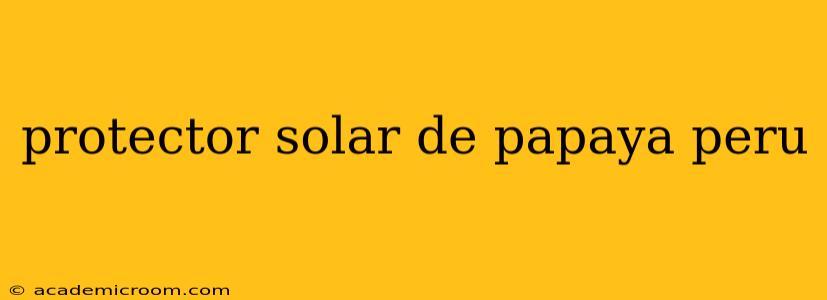Protector Solar de Papaya: Beneficios y Consideraciones para la Piel Peruana
The sun is a powerful force in Peru, with its intense rays demanding diligent sun protection. While many readily reach for commercial sunscreens, a growing interest surrounds natural alternatives like papaya-based sun protection. This article explores the potential benefits and considerations of papaya-based sunscreens, specifically for Peruvian skin.
What are the benefits of using a papaya-based sunscreen?
Papaya is rich in antioxidants like vitamins A and C, which are known to combat free radical damage caused by UV radiation. These antioxidants can help protect skin from premature aging, wrinkles, and hyperpigmentation—common concerns in Peru's sunny climate. Furthermore, some proponents suggest that papaya extracts may offer some degree of natural sun protection. However, it's crucial to understand that the level of protection offered by papaya alone is likely insufficient for complete sun safety.
Does papaya sunscreen provide enough SPF protection?
This is a critical point. While papaya contains beneficial antioxidants, it does not provide a sufficient Sun Protection Factor (SPF) to adequately shield your skin from the harmful effects of the sun. Any product marketed as a "papaya sunscreen" should be carefully examined for its SPF rating and other listed ingredients. A high SPF, typically 30 or higher, is recommended for effective protection against UVB rays, which cause sunburn. Papaya extract might be an added ingredient offering antioxidant benefits, but it shouldn't be the primary source of sun protection.
What other ingredients should I look for in a sunscreen, even if it contains papaya?
A good sunscreen, regardless of whether it contains papaya extract, should include broad-spectrum protection. This means it protects against both UVA and UVB rays. UVA rays penetrate deeper into the skin and contribute to premature aging and skin damage. Look for sunscreens that list ingredients like oxybenzone, avobenzone, or zinc oxide, which are effective UVA and UVB blockers.
Are there specific concerns for Peruvian skin regarding sunscreens?
Peruvian skin varies greatly depending on ethnicity and altitude. However, generally speaking, sun sensitivity is a major concern due to the high altitude and intense UV radiation in many parts of the country. Choosing a sunscreen with a high SPF and broad-spectrum protection is paramount, regardless of the presence of papaya extract. Furthermore, consider your skin type: oily skin might benefit from a gel or lotion, while dry skin may prefer a cream.
Can I make my own papaya sunscreen at home?
While DIY sunscreens are popular, it's extremely difficult to accurately measure the SPF of a homemade product. Attempting to rely solely on a homemade papaya-based sunscreen for sun protection is strongly discouraged. It's crucial to use commercially available sunscreens with accurately tested SPF ratings to ensure adequate protection.
What are some alternatives to commercial sunscreens?
If you're concerned about the chemicals in commercial sunscreens, research mineral sunscreens. These sunscreens use ingredients like zinc oxide and titanium dioxide, which are considered safer and gentler on the skin. However, remember that even mineral sunscreens must provide a high enough SPF to be effective.
In conclusion:
Papaya extract can offer additional antioxidant benefits to your skincare routine, but it is not a sufficient substitute for a broad-spectrum sunscreen with a high SPF. Protect your skin from the strong Peruvian sun by using a reliable sunscreen with a high SPF and broad-spectrum protection, incorporating additional skincare with antioxidants like those found in papaya as a complementary step. Always consult a dermatologist if you have concerns about specific skin conditions or reactions to sunscreen ingredients.
